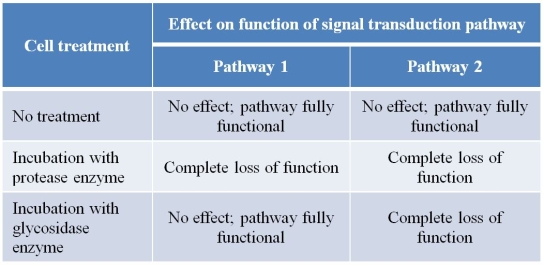Multiple Choice
Refer to the table below.  The table summarizes results of experiments using whole cells.Cells were either incubated without an enzyme (control) or incubated with an enzyme.Proteases degrade proteins, and glycosidases degrade oligosaccharides.Which hypothesis is supported by these results?
The table summarizes results of experiments using whole cells.Cells were either incubated without an enzyme (control) or incubated with an enzyme.Proteases degrade proteins, and glycosidases degrade oligosaccharides.Which hypothesis is supported by these results?
A) Receptors for signal transduction pathways 1 and 2 bind the same ligands.
B) Receptors for signal transduction pathways 1 and 2 bind ligands that recognize glycoproteins.
C) Receptors for signal transduction pathways 1 and 2 bind ligands that recognize nonglycosylated proteins.
D) Pathway 1 involves a ligand that recognizes a nonglycosylated protein receptor, and pathway 2 involves a ligand that recognizes a glycoprotein receptor.
E) Pathway 1 involves a ligand that recognizes a glycoprotein receptor, and pathway 2 involves a ligand that recognizes a nonglycosylated protein receptor.
Correct Answer:

Verified
Correct Answer:
Verified
Q58: Gap junctions are a specialized component of
Q59: Refer to the table below showing the
Q60: Autocrine signals bind to<br>A) receptors on adjacent
Q61: Which statement about intracellular receptors that respond
Q62: The membrane-lined tunnels that traverse the cell
Q64: Some of the stem cells in bone
Q65: A molecule functioning as an antagonist binds
Q66: Refer to the figure below. <img src="https://d2lvgg3v3hfg70.cloudfront.net/TB5650/.jpg"
Q67: Refer to the table below. <img src="https://d2lvgg3v3hfg70.cloudfront.net/TB5650/.jpg"
Q68: Which is a similarity between gap junctions